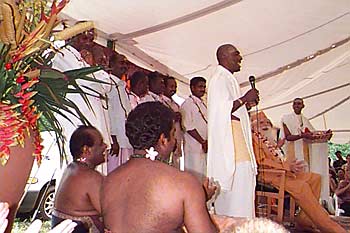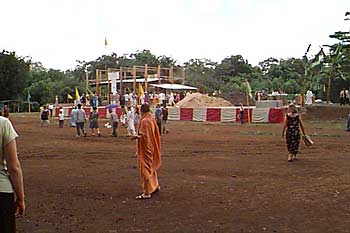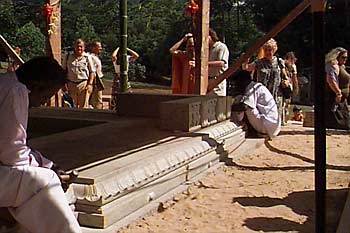Blog Archives

“Occasionally, in a cross-section of the inner mind, when light merges into transcendental form, the young aspirant may view the golden actinic face of a master peering into his, kindly and all-knowing. He is looking at his own great potential. As the clear white light becomes more of a friend to his external mind than an experience or vision and can be basked in during contemplative periods of the day, the nourishment to the entirety of the nerve system, as ambrosia, bursts forth from the crown chakra. This is identified inadequately as “the peace that passeth understanding,” for he who reaches this state can never seem to explain it. “
–Gurudeva from Merging with Siva.
Our Beloved and Revered Satguru Sivaya Subramuniyaswami
Attained Maha Samadhi on November 12th, 2001
Click to read for Details.
Mystic Mouse Coloring Book Now available
Today’s sample page. —– Click here to get your copy today!

Today we were honored with the visit of Sri Kumarswami Dikshitar, a wonderful Sivacharya who performed the Kumbhabhishekam ceremonies for our Kadavul Nataraja temple in 1985. Bodhinatha went briefly to the temple to listen to him chant Sri Rudram during the morning puja and recounts:
“This morning we had an auspicious event. I was standing in front of Kadavul listening to the priests chanting rudram and just as the Namah Sivaya line, which is the center of the Vedas, was being chanted another guest handed me a small bottle of water from Lake Mansarovar. Om Namah Sivaya.”
Lake Mansarovar is in the Himalayas next to Mount Kailas.
Cybertalk: Kauai Innersearch Day 3, Part 1: Bodhinatha begins this day’s
talk with a joke about monism, then reads from a Transcendental Meditation
(TM) brochure on how to fix your karma by doing graha puja, or worship of
the planets, elaborating on the false concept that the planets and our
astrology is responsible for our karma.
Cybertalk Ends”
For more information about listening to Gurudeva’s talks online and to hear them in other formats, click here.
And click here for an Index to All Past CyberTalks.
Study Gurudeva’s teachings
every day. Visit the Master Course site!
Bodhinatha will be happy to hold “Prasnottara Satsang” — “Questions and Answers” over the telephone with any Hindu religious societies, Hindu youth groups, Radio talk show hosts etc. All you need is a phone with a speaker and an enthusiastic audience. Arrangements may be made in advance by sending email to Sadhaka Mahadevan
If you are experiencing any problems listening to the audio, please to go our Audio FAQ page for sound geeks and follow the directions there.
 |
|
|
 |
||
Shri Kumaraswamy Dikshitar is working hard to build a new trained priesthood in the US, one that is independent of temple trustees or boards of directors and who have a social standing equal to doctors, engineers or clergy of other religions instead of being relegated to the position of indentured labourers brought over to the US on short term Visas, to be treated as servants and then sent back to India. This “raising up” of the priesthood was a vision that Gurudeva himself planted in the minds of the US Hindu priests. Dikshitar publishes the Veda Agama Sudha in the US. You may also visit his web site at:
http://www.sivaguruashram.com/home.html
Here is Dikshitar with his wife, his son Balasubramaniam and daughter-in-law. Kumarswamy’s sons have followed him faithfully into the priesthood.
Among the Sivacharya’s the line of guru’s flows through the family itself from father to son. Here he show the mala that came down to him from his grand father. During the morning puja, Kumarswami and his son chanted Sri Rudram before Lord Nataraja. Dikshitar and his son have been serving at a Hindu temple in Albany, New York for nearly 20 years. He plans to retire in three years time and start his new priesthood program which will sponsor priests from India and help them get established in the US. Currently many temples sponsor the visas for priests and then fire them after two years of service, even if they have a four year visa. He plans to sponsor priests whose visa has not expired but whose services were terminated at temples,\ and help them get established in the community by creating their own temples and doing community services for Hindus. He has already done this for four priest families.
At our publication facility we showed Dikshitar around and he was interviewed about his work and plans by our Hinduism Today staff.
A late camera download from yesterday: Guests who dropped by from Albany, New York, who by coincidence also know Shri Kumarswami Dikshitar. On the right, Mr. Perumal and his wife Radharani. On the left, his son Shankara and in the middle is Balaji.
The nephew and niece of Paramacharya Palaniswami came for a visit today: Shan and his sister Lisa. They were given a full tour of the shop. Here they stop in to visit Sivakatirswami and learn about our web operations and all the wonderful people around the world helping with our work.
A group of nurses dropped by with Isani Alahan and Savitri Kumaran. These ladies are involved in the Healing Touch movement where nurses are trained to send prana through their hands to help heal and also facilitate recovery from surgery. Their work has been so successful that even many mainstream hospitals are encouraging the practice among their staff.
Our own wonderful homa priest and monk, Sadhaka Tyaganatha.
 The Remarkable Vision |
Iraivan Temple Progress Update |
Join this historic undertaking. Please contribute generously. Sponsor a stone today! |

Marian Yee, guest from Honolulu, at the Open House held last year in July, when we invited people from the islands to come to view the iraivan Temple construction, recently discovered photos from that event in her digital camera. Here is Sadhaka Thondunatha making announcements on the podium with Gurudeva. For those who may be wondering, Sadhaka Thondunatha is on sabbatical in Sri Lanka to be with his parents whom he hasn’t seen in many years.

More pictures from the open house. At that time the temple was only up a few courses.

A lot of progress has been made in a year since this photo was taken.

Neesha and a young lady from Singapore joined to present a wonderful Bharata Natyam performance at the event.

Neesha studied for five years in India at Kalashetra School of Arts. Her father and mother made a “breakthrough” decision and actually moved to Chennai while their daughters went to school there. They now live on Kauai and are doing wonderful karma yoga while living in the proximity of the temple.

This was an awesome moment for many of our island friends, when, last year, they saw for the first time the manifestation of what they had been hearing about for many years. Today, the island views the temple and Kauai’s Hindu Monastery as one of the spiritual anchors for the entire island.

|
Study Gurudeva’s teachings.
|
transcription begins
Date: June_14_2002
Title: Satya, or Truthfulness
Category: Yamas and Niyamas
Duration: 14 min., 31 seconds
Date Given: May 13, 2002
Given by: Bodhinatha
The second Yama is truthfulness, Satya, refraining from lying and betraying promises.
As nonviolence is linked to Santosha, contentment, so truthfulness is linked to Arjava, honesty. If we are being dishonest in our actions, then usually we have to lie in our speech to cover it up, right? If we are doing things we should not, particularly on an ongoing basis we have to lie about it, we cannot tell people, we will get in trouble. We might even end up in jail. So, the two go together. Therefore, we need to have the honesty part under control.
One of the problems of lying is, you usually just cannot tell one lie. You tell one lie and then that requires another lie to cover up that lie, which requires a third lie and then you have to tell a fourth lie and then a fifth lie. You have to remember all the lies you have told, so you don’t contradict yourself as far as the sixth lie and so forth. Boy, it gets complicated! All of this is going into the subconscious mind, this whole lying pattern and of course, it is causing a negative condition in the subconscious mind. Just like a layer of darkness, a layer of dirt that is thrown all over the floor. If you do that enough times, you really create a significant amount of dirt in the subconscious mind, create a messy floor which covers up the soul nature. You cannot get to the soul nature anymore because you put all of this in your subconscious mind. So, you have to take time to get it out.
Gurudeva describes three levels of lying, three levels of non-truthfulness. The first level is when someone is in a state of fear and does not tell the truth, to protect himself. That is quite common in homes, when a young child won’t tell the truth. Something broke, fell off and broke. He didn’t do it, somebody else did it. Because, he is afraid of getting punished. The fear of getting punished can build the practice of lying. So obviously, we want to minimize that fear of punishment because otherwise children are going to lie and get in the habit of lying. We need a situation where children feel free to tell what happened without feeling threatened that they are going to get hit, that is the worst kind of threat because that creates a real sense of fear. A fear that you are going to get hit because you did this is a strong fear. So we need a non-threatening environment. Not that children cannot be disciplined for breaking something, it is that we don’t want the discipline to make them afraid. We don’t want the discipline to be physical nor do we want it to be excessive. Somehow it has to be appropriate and given in a kindly way. We need a non-threatening environment and encourage this first level of lying not to take place.
Second level is deliberately lying about another, making up stories for the delight of getting that person in trouble. This is like when one sibling enjoys getting the other sibling in trouble, making up stories. But we don’t know anyone like that, right? It happens. Again a lot of it is related to the same problem – lack of contentment. If we are discontent, why not get our brother or sister in trouble? Then they will be upset too, then I won’t be alone. Again, if we can keep ourselves or keep the children in a content, peaceful state of mind there is less of a tendency to disturb and cause problems in this way.
The third and worst level of non-truthfulness is calculated deception, breaking of promises. Of course, calculated deception is definitely tied to dishonesty. This is much different than just lying because you are afraid. Very, very different. You have done something dishonest. Say for example, you are a salesman selling something and you are misrepresenting it. You are selling it for a thousand dollars when it is really only worth five hundred dollars and you know it. Consequently to be dishonest you have to lie, you could not sell it for a thousand dollars, if you told them the truth. So in trying to sell it you are being dishonest and going along with lying, which is called calculated deception.
Breaking of promises is when we tell someone we will do something and we don’t really have the intention to do it. A subtle form of lying but it causes the same problem. Say for example, someone tells us a secret and they tell us this secret based upon the fact that they asked before they told it that, “If I tell you this, do you promise not to tell it to anyone else?” You say, “Of course.” But you don’t intend not to tell anyone else. You don’t particularly have a plan in mind to tell the whole world, but you definitely are not committed to not telling someone else. So they tell you and you end up telling others and end up telling a few more and telling a few more. You really didn’t have in mind, living up to your promise in the first place. So that is a form of lying, sophisticated form of lying. We want to avoid that as well.
The Tirukural has a lot of good advise in this area. The first verse in the chapter on Truthfulness, reads as follows. “What is truthfulness? It is speaking words which are totally free from harmful effects.” That is very interesting. It is tying harm, it is tying ahimsa in to truthfulness, it is speaking words which are totally free from harmful effects. So that means, truthfulness isn’t just going around telling the truth. You have to tell it in a way that doesn’t hurt people unnecessarily. You don’t want to just walk up to someone and say, “You are very fat.” That is hurting them unnecessarily. There is no reason to say that truth in that way and hurt someone’s feelings. We need to temper the truth in a way that doesn’t hurt people unnecessarily.
Second verse also is of a similar nature, helps us understand truthfulness. “Even falsehood is of the nature of truth if it renders good results, free from fault.” How can falsehood be true? That is a contradiction, if you say something that is not true. How can it be true? Well, because sometimes the truth would hurt too much. So you don’t want to hurt people with the truth. For example, Gurudeva gives the example of the astrologer. The astrologer is looking at someone’s chart and sees a number of problems coming up in the next twelve years, huge number of problems. Is the astrologer supposed to tell all the problems that will happen to the person in the next twelve years, one by one.? No, it would discourage the person too much, he might just give up. He wouldn’t have the strength to get through it all. They realize that, “If I get through the first one, there is eleven more left. How am I ever going to manage?” So, the astrological code as explained by Gurudeva is, you don’t tell every detail. You can say you are going to have a difficult period but you don’t necessarily explain the extent of the difficulty because you would discourage the person too much. You don’t want to tell them it is going to be a great period. You don’t want to say a falsehood in that sense but you don’t want to give every single negative detail.
The other example Gurudeva gives is the physician. The physician diagnoses the patient, realizes everything that is wrong. Does he automatically tell the patient everything that is wrong? No, if he says everything that is wrong the patient can get too discouraged and get depressed. In that state of mind, he would never get his health back. So you have to temper it, you don’t want to discourage the patient beyond the point of what he can handle.
Those are examples of when not telling the full truth is truthfulness because you don’t want to harm someone unnecessarily. This applies particularly to professional ethics we are talking about here. You don’t want to harm someone.
With children, the same thing. You don’t want to tell the child everything he is doing wrong, all at once necessarily. It would be too overwhelming. You work on one thing at a time, help the child improve. So we need to keep that in mind.
There is another aspect of truthfulness, which is the cultural differences. Particularly, if we have not traveled a lot internationally or met people from different backgrounds. We can tend to think that people think just like us and this applies to truthfulness as well. How we look at truthfulness is how they look at truthfulness. But this isn’t the case. Different cultures handle truthfulness in different ways. We need to take that into account and not judge somebody as being untruthful just because the way they go about being truthful, is different culturally from the way we do.
For example, when you say “Yes”, in different cultures it means different things. “Yes” in one culture can be a polite “No.” It is too rude to say, “No.”
“Will you come back next week?” Yes. “Will you come back next week?” No.
If you say “No,” it is kind of rude in some cultures, but it is truthful. If you say “Yes” to “Will you come back next week?”, that is a polite “No”, in some cultures. They know that means “No”. They don’t expect that means “Yes”. It would be rude to say, “No.” If you are not ready for that, you can get confused. You say, “Well, those people never tell the truth. When they mean “No, they say “Yes”.”
So we have to get over the fact that we are expecting other cultures to be like our culture, that everyone was raised with the same concept of truthfulness that we were raised with. It is not that way. We can learn something new about truthfulness all the time.
Another example is ‘Business Contracts’, in terms of truthfulness. In one culture, you sign a business contract and that is it. Everyone goes forward on the contract. In other cultures, every week you renegotiate the contract. The contract was just the starting point. It wasn’t a final bargain, it wasn’t an agreement. It was just where you were when you started and every week one of the parties might try to renegotiate it, have it better for him than when it started.
In one culture that would be looked at as, “This isn’t right.” In another culture, “Well, that is just the way business is done. Of course, we are renegotiating it, we will renegotiate it four or five times before we are done. That is how we do business, that is how we get a good deal.”
The idea is, don’t be too quick to judge others as being untruthful. It may just be that they were raised with different concepts of what truthfulness is.
Then again, Gurudeva closes the chapter with some advise for mathavasis, interesting advise. He points out that, “Only the Guru has permission to correct the faults in his monks. The Guru has been given permission to do that by each mathavasi taking Him as the Guru. If mathavasis discipline one another, psychoanalyze and correct in the name of truthfulness, this violates the first yama of non-injury.”
That is interesting, that Gurudeva sticks something just for monks at the end of each of these. So that was his message on truthfulness and non-injury for monks.
Have a wonderful day.
transcription ends
|
MORE UPLIFTING THINGS |
Innersearch 2003-4 in India!
We just completed the July 17-23 Kauai Innersearch, 2002. Bodhinatha will lead the next Innersearch to India, between Dec 2003 and Jan 2004. We will visit Bangalore and the Iraivan Carving Village, and settle in the South in Tamil Nadu, Click on the above for details on what will be an inspiring journey to our holy land of Bharat! |
|

|
Check our children and youth section for new items for the young and young at heart! | |
|
1. SIGN OUR GUESTBOOK and receive a FREE GIFT |
||
| 2. Newest Book: LIVING WITH SIVA | ||
|
3. Visiting KAUAI’S HINDU MONASTERY |
||
|
4. Contribute to THANK YOU, GURUDEVA FUND |
||
From Our Gurus' Teachings
Archives are now available through 2001. Light colored days have no posts. 1998-2001 coming later.
